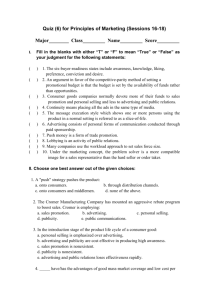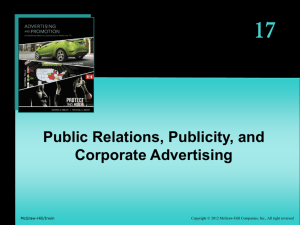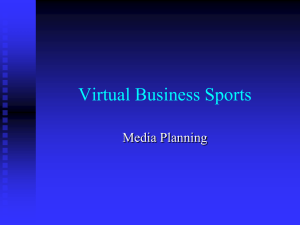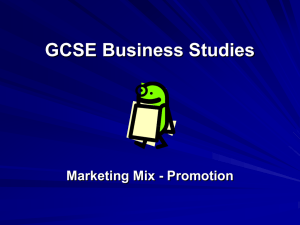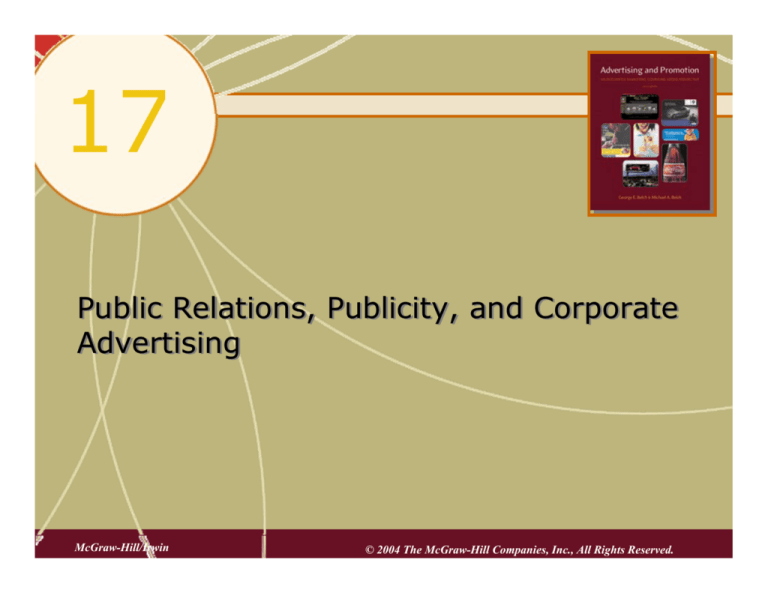
17
Public Relations, Publicity, and Corporate
Advertising
McGraw-Hill/Irwin
© 2004 The McGraw-Hill Companies, Inc., All Rights Reserved.
The Role of Public Relations
To manage relationships with the public
General
Public
Customers
Employees
CLIENT
Suppliers
Stockholders
Public Relations Management Process
¾ Determination and evaluation of
public attitudes
¾ Identification of policies and
procedures of an organization
¾ Development and execution of the
program
Marketing Public Relations (MPR) Functions
Building marketplace excitement before media
advertising breaks
Creating advertising news where there is no
product news
Introducing a product with little or no
advertising
Providing a value-added customer service
Building brand-to-customer bonds
Influencing the influentials/opinion leaders
Defending products at risk and giving
customers a reason to buy
Segway: An Example of MPR’s at Work
The Process of Public Relations
¾ Determining and evaluating public
attitudes
¾ Establishing a PR plan
¾ Developing and executing the PR
program
Research on Public Attitudes
¾ Provides input for the planning process
¾ Serves as an “early warning system”
¾ Secures internal cooperation, support
¾ Increases communications effectiveness
Evaluating Public Relations Plans
1.
Does the plan reflect a thorough understanding of the
company’s business situation?
2.
Has the PR program made good use of research and
background sources?
3.
Does the plan include full analysis of recent editorial
coverage?
4.
Do the PR people fully understand the product’s
strengths and weaknesses?
5.
Does the PR program describe several cogent, relevant
conclusions from the research?
Evaluating Public Relations Plans
6.
Are the program objectives specific and
measurable?
7.
Does the program clearly describe what the PR
activity will be and how it will benefit the company?
8.
Does the program describe how its results will be
measured?
9.
Do the research, objectives, activities, and
evaluations tie together?
10.
Has the PR department communicated with
marketing throughout the development of the
program?
Public Relations Audiences
¾ Employees of the firm
¾ Stockholders and investors
¾ Community members
¾ Suppliers and customers
¾ The media
¾ Educators
¾ Civic and business organizations
¾ Governments
¾ Financial groups
Public Relations Tools
¾ Press releases
¾ Press conferences
¾ Exclusives
¾ Interviews
¾ Community involvement
¾ The internet
Example of a Press Release
Reebok Used a Press Conference to
Announce the Sponsorship of Shakira
Telling the Story
¾ Technological methods make it
easier for the press
¾ They increase the likelihood
media will use the story
– Telephone press conferences
– In-studio media tours
– Multicomponent video news releases
(VNR)
– Targeted wire stories
PR Publications
Inserts
Enclosures
Annual reports
Posters
Bulletin boards
Exhibits
Audiovisuals
Position papers
Speeches
News releases
Media kits
Booklets
Leaflets
Pamphlets
Brochures
Manuals
Books
Letters
Advantages of Public Relations
¾ Credibility
¾ Cost
¾ Avoidance of clutter
¾ Lead generation
¾ Selectivity
¾ Image building
Criteria for Measuring PR Effectiveness
¾Total number of impressions . . .
Over time
On the target audience
On specific target audiences
¾Percentage of . . .
Positive articles over time
Negative articles over time
¾Ratio of positive to negative articles
¾Percentage of positive and negative
articles by . . .
Subject
Publication
Reporter
Target audience
Publicity
Publicity involves the generation of news about a
company, product, service, brand or person in various
media. It is a subset of the public relations effort.
Key points regarding publicity:
¾ Publicity is generally short-term
focused
¾ Publicity is not always under the
control of the firm
¾ Publicity can be negative as well as
positive
The Power of Publicity
¾Perceived as more credible
¾Often perceived as endorsed by the
medium in which it appears
¾Often has high news value
¾Often generates high frequency of
exposure
Publicity Vehicles
Feature
Articles
Special
Events
Captioned
Photos
News
Releases
Press
Conferences
Responding to Publicity
Using Positive Publicity
Advertising Versus Publicity
Factor
Advertising
Publicity
Control
Great
Little
Credibility
Lower
Higher
Reach
Achievable
Undetermined
Frequency
Schedulable
Undetermined
Cost
Specific/High
Unspecified/Low
Flexibility
High
Low
Timing
Specifiable
Tentative
Corporate Advertising
Advertising done to promote the interests of the firm
by enhancing its image, assuming a position on a
particular issue or promoting a certain cause
Types of Corporate Advertising
¾Image Advertising
¾Event sponsorship
¾Advocacy advertising
¾Cause-related advertising
Objectives of Corporate Advertising
¾Create a positive image for the firm
¾Communicate the organization’s
viewpoint on various issues
¾Boost employee morale
¾Smooth labor relations
¾Help newly deregulated industries
¾Help diversified companies establish an
identity
Chevron Engages in Image Advertising
Event Sponsorship – a form of marketing communications
whereby an organization becomes involved with a
particular event by developing sponsorship relations.
Events used for sponsorship:
• Sporting events
• Music/entertainment
• Festivals
• Arts/cultural events
• Causes
Advocacy Advertising
Advocacy advertising is the propagation of
ideas and elucidation of controversial social
issues of public importance in a manner that
supports the interests of the sponsor
The San Diego Zoological Society uses
advocacy advertising
Cause Related Marketing
Cause related marketing is a form of
marketing whereby companies link with
charities or nonprofit organizations as
contributing sponsors
KitchenAid uses cause-related marketing

